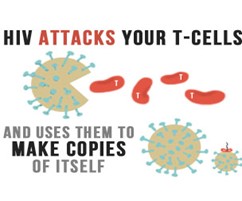Click here to watch an overview video on HIV/Aids



What is HIV?
To understand what HIV is, let’s break it down:
H – Human – This particular virus can only infect human beings.
I – Immunodeficiency – HIV weakens your immune system by destroying important cells that fight disease and infection. A "deficient" immune system can't protect you.
V – Virus – A virus can only reproduce itself by taking over a cell in the body of its host.
Human Immunodeficiency Virus is a lot like other viruses, including those that cause the "flu" or the common cold. But there is an important difference – over time, your immune system can clear most viruses out of your body. That isn't the case with HIV – the human immune system can't seem to get rid of it. Scientists are still trying to figure out why.
We know that HIV can hide for long periods of time in the cells of your body and that it attacks a key part of your immune system – your T-cells or CD4 cells. Your body has to have these cells to fight infections and disease, but HIV invades them, uses them to make more copies of itself, and then destroys them.
Over time, HIV can destroy so many of your CD4 cells that your body can't fight infections and diseases anymore. When that happens, HIV infection can lead to AIDS.
What is Aids?
To understand what AIDS is, let’s break it down:
A – Acquired – AIDS is not something you inherit from your parents. You acquire AIDS after birth.
I – Immuno – Your body's immune system includes all the organs and cells that work to fight off infection or disease.
D – Deficiency – You get AIDS when your immune system is "deficient," or isn't working the way it should.
S – Syndrome – A syndrome is a collection of symptoms and signs of a disease. AIDS is a syndrome, rather than a single disease because it is a complex illness with many complications and symptoms.
Acquired Immunodeficiency Syndrome is the final stage of HIV infection. People at this stage of HIV disease have badly damaged immune systems, which puts them at risk for opportunistic infections (OIs).
You will be diagnosed with AIDS if you have one or more specific OIs, certain cancers, or a very low number of CD4 cells. If you have AIDS, you will need medical intervention and treatment to prevent death.
For more information, see CDC’s Basic Information about HIV and AIDS.
Where did HIV come from?
Scientists identified a type of chimpanzee in West Africa as the source of HIV infection in humans. The virus most likely jumped to humans when humans hunted these chimpanzees for meat and came into contact with their infected blood. Over several decades, the virus slowly spread across Africa and later into other parts of the world. For more information, see CDCs.